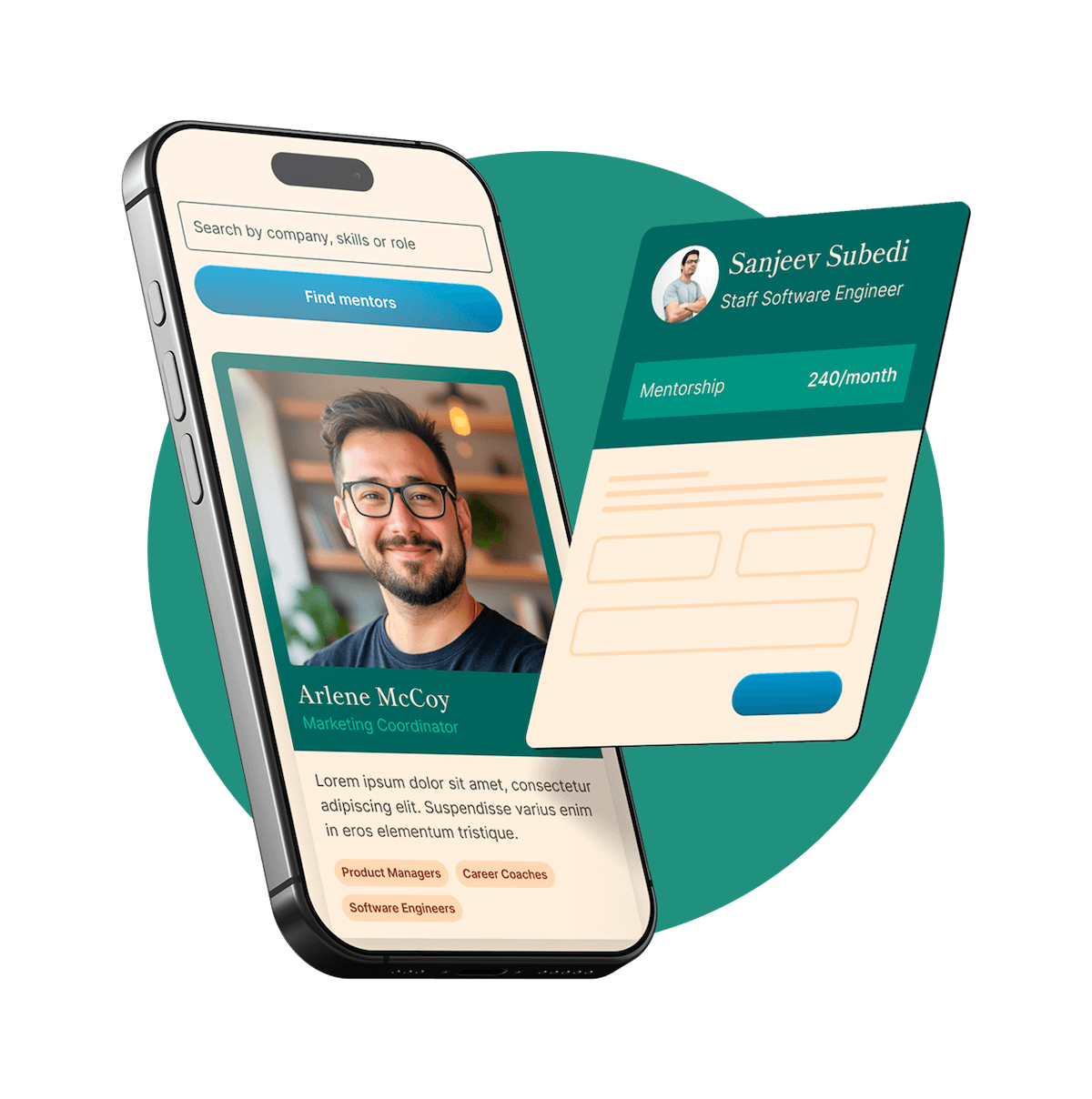Tired of trying to learn about HTML on your own? Book an online lesson with a qualified tutor to learn all about HTML. Our online tutors make HTML lessons fun and easy.













Want to start a new dream career? Successfully build your startup? Itching to learn high-demand skills? Work smart with an online mentor by your side to offer expert advice and guidance to match your zeal. Become unstoppable using MentorCruise.
Thousands of mentors available
Flexible program structures
Free trial
Personal chats
1-on-1 calls
97% satisfaction rate

5 out of 5 stars
"Having access to the knowledge and experience of mentors on MentorCruise was an opportunity I couldn't miss. Thanks to my mentor, I managed to reach my goal of joining Tesla."

5 out of 5 stars
"After years of self-studying with books and courses, I finally joined MentorCruise. After a few sessions, my feelings changed completely. I can clearly see my progress – 100% value for money."

One-off calls rarely move the needle. Our tutors work with you over weeks and months – helping you stay accountable, avoid mistakes, and build real confidence. Most mentees hit major milestones in just 3 months.
We don't think you should have to figure all things out by yourself. Work with someone who has been in your shoes.
Get pros to make you a pro. We mandate the highest standards for competency and communication, and meticulously vet every HTML tutors and coach headed your way.
Master HTML, no fluff. Only expert advice to help you hone your skills. Work with HTML tutors in the trenches, get a first-hand glance at applications and lessons.
Why learn from 1 tutor when you can learn from 2? Sharpen your HTML skills with the guidance of multiple tutors. Grow knowledge and open-mindedly hit problems from every corner with brilliant minds.
Pay for your HTML tutor session as you go. Whether it's regular or one-off, stay worry-free about tuition or upfront fees.
Break the ice. Test the waters and feel out your HTML tutor sessions. Can your coach teach the language of the coding gods passionately? With ease? Only a risk-free trial will tell.
Never feel trapped in your HTML mentorship. Grow fearlessly as a professional HTML expert by retaining the ability to end, pause, and continue your mentorship subscription as you please.
Why learn without help when you can learn with it? A HTML tutor can help you understand core concepts, clarify doubts, and keep you on track. They can also help you learn more efficiently by providing you with a personalized learning plan and resources.
Profit from personalized online lessons from the comfort of your home, office, or anywhere else.
Go beneath the surface of your HTML lessons with a HTML tutor who can help you understand complex concepts and theories.
Keep up with your HTML lessons and stay motivated with help from your tutor.
How an HTML tutor can help you build your first website. An HTML tutor gives you one to one instruction that turns web development basics into clear steps you can follow. You learn what each tag does, how pages are structured, and how to connect HTML with CSS and JavaScript so a simple idea becomes a working site. You also get real projects, fast feedback, and a steady plan that fits your pace. The result is momentum and a site you can show.
An HTML tutor is an experienced developer who teaches you how to structure content for the web. The focus is practical. You learn how documents are built, how browsers read markup, and how to use semantic tags so content is clear to people and machines. A good tutor adapts to your goals, reviews your pages, and explains tradeoffs in plain language. Think of HTML as the skeleton of a page. CSS is the skin and clothes. JavaScript adds behavior. Your tutor keeps that model front and center so you build with purpose.
Learning alone can feel messy. Tutorials move at a fixed pace and cannot see where you get stuck. An HTML tutor meets you where you are and focuses on gaps that slow you down. You learn faster because you work on the right thing at the right time. You also avoid habits that create bugs or accessibility issues later. If your goal is to learn HTML so you can build a website, targeted guidance saves time and keeps motivation high.
Beginners often treat HTML like a bag of tags. An HTML tutor shows you how to think in sections and landmarks so content has meaning. You learn when to use header, nav, main, section, article, aside, and footer. You practice proper nesting and heading levels for clean outlines. You add alt text that explains images. You label forms so assistive tech reads them well. This is HTML help that pays off in readability, SEO, and accessibility.
Your first site should look good on a phone and on a laptop. A tutor will show you how to structure markup that plays well with modern CSS. You learn mobile first layout thinking, sensible class names, and markup that supports flexbox and grid. You practice image markup that respects aspect ratio and uses width and height for faster paint. You keep the HTML lean so CSS can do its job.
You will make mistakes. That is part of learning. A tutor helps you recognize common errors fast. You learn how to spot missing closing tags, unbalanced quotes, and invalid nesting. You become comfortable with browser developer tools, the Elements panel, and the Accessibility tree. You build a simple checklist you can run before you hit publish.
A strong plan covers fundamentals first, then layers in patterns you will use often. Here is what a complete path can include.
elements and tags with start and end markers
attributes and values for links, images, and media
document structure with doctype, HTML, head, and body
headings, paragraphs, lists, quotes, and code snippets
links and navigation patterns for clear journeys
using header and main to define landmarks
grouping related content with section and article
when to use aside and footer without confusion
setting correct heading levels for a logical outline
writing text alternatives with meaningful alt
modern image markup with img, picture, and srcset
captions and figure for images that need context
audio and video with controls and track for captions
safe use of iframes for maps and embeds
form, label, input, select, textarea, and button
required fields and constraint validation
accessible error messages with aria live and helpful copy
grouping with fieldset and legend for clarity
table, thead, tbody, tfoot, tr, th, and td
scope and headers for accessible relationships
simple and readable tables with captions
linking stylesheets and placing scripts with intention
deferring scripts so content loads first
using classes and ids without overloading the markup
small progressive enhancement patterns that work without JavaScript
language attributes, titles, and metadata that inform agents
focus order that matches visual order
roles and aria attributes used only when needed
keyboard friendly patterns for links and buttons
clean markup that avoids extra wrappers
useful metadata with title and description
preload and preconnect when you add assets later
simple sitemaps and friendly link text
Projects make learning real. Your tutor will help you pick scope that fits your time and goals. Here are examples that teach useful skills.
personal portfolio with a home page, about page, and contact form
blog layout with articles, tags, and a simple archive
event landing page with a schedule and registration section
small business site with product features and a contact card
recipe page that uses semantic lists and figure with captions
gallery page that pairs figure and figcaption with responsive images
Each project includes a repo, a short README, a checklist for accessibility, and a simple plan for the next improvement. You practice version control and learn to explain decisions in a few sentences. That is how you build trust when you share your work.
Structure helps you turn effort into progress. A good rhythm has both live time and short async support so you do not stall.
Share goals and constraints so you both know the target.
Review a small sample of your markup or a simple wireframe.
Set a two week plan with one project and a few checkpoints.
Agree on tools and a feedback channel you will both use.
Meet for a focused session with one topic and one outcome.
Build a small slice of your project and commit your work.
Ask short questions between calls so blockers do not pile up.
Review progress and raise the bar a little each week.
write a short list of questions in your own words
push your latest code and share a link before the call
note anything that confused you or took too long
pick one area where you want deeper feedback
This habit speeds up learning and makes sessions productive.
An HTML tutor adapts to your stage so time goes into the right skills.
Focus on core tags, structure, and a simple project. You learn how browsers read markup and how to avoid common mistakes. You leave with a one page site and the confidence to add a second page on your own.
Align with course topics while building practical artifacts. You get help on assignments without crossing academic lines. You practice clean code, proper citations, and simple documentation. Grades improve because your understanding improves.
Add depth in semantics, forms, and accessible patterns. Connect HTML to CSS grid and flexbox. Learn how to hand off clean markup to JavaScript without mixing concerns. Build a small portfolio that shows thoughtful structure.
Learn enough to read and discuss markup in meetings. Build a small internal page or improve a help center article. Understand limits and possibilities so scoping and collaboration improve.
A deliberate search makes the first month smooth and productive.
Write down one or two outcomes for the next quarter. List how many hours you can give each week. Clear targets help a tutor shape the plan and help you measure progress.
Remote sessions remove commute time and open up more choices. You can match on time zone, industry, and teaching style. You also get async reviews between calls which keep momentum.
Look for tutors who show concrete examples, explain how they teach, and write clearly. Favor profiles that mention accessibility and structure, not just tools. Read reviews that point to specific wins and changes in skill.
Bring a simple wireframe or a small page outline. Notice how the tutor asks questions, explains tradeoffs, and sets next steps. You want clarity and calm coaching, not just fast typing.
Confirm the weekly slot, response times, and what is included. Decide how you will share code and feedback so nothing falls through the cracks.
You can browse experienced HTML tutors on MentorCruise, filter by skills and availability, read student feedback, and book a short intro call. It is a simple way to match with a tutor who fits your goals and schedule.
Rates vary with experience, scope, and format. Hourly sessions work well for targeted HTML help or quick reviews. Monthly coaching adds steady practice and async feedback, which is useful when you want to build and ship a first site. Small group options reduce cost and add peer support. Value comes from outcomes you can point to such as a finished page, a cleaner form, or a faster layout.
You can learn a lot from documentation and practice sites. MDN Web Docs is a reliable reference for elements and attributes. Open courseware and tutorials can fill gaps and give you exercise ideas. An HTML tutor brings those pieces together. You get a plan that fits your goals, feedback that is specific to your code, and a push to finish and publish. Many learners use both. They read and practice on their own, then use sessions to refine and move faster.
headings out of order that break the page outline
div soup that hides meaning and hurts accessibility
missing alt text that leaves images as mysteries
forms without labels that confuse assistive tech
tables used for layout that create maintenance pain
heavy markup that fights the CSS layout
scripts in the head that block content paint
You fix these by learning a few simple rules and practicing them until they stick. A tutor reinforces the rules and shows you why they matter.
Week one. Learn page structure and build a one page profile. Add meaningful headings, lists, and links. Write alt text for images.
Week two. Add a contact form with labels and basic validation. Create a simple gallery that uses figure and figcaption. Test with the keyboard.
Week three. Split the site into two or three pages with clean navigation. Improve performance with proper image sizes. Write a short README and publish.
You end with a site you can share and a checklist you can reuse.
No. HTML comes first. Your tutor will introduce CSS and JavaScript only when the project calls for them.
Most beginners publish a simple site within two to four weeks when they practice a few hours each week and keep scope small.
Yes. A tutor can explain concepts, review your approach, and show patterns. They will not do graded work for you. The goal is to have learning that you can show.
A modern browser, a code editor, and a git client are enough. Your tutor will help you set up a simple folder structure and a repo.
Yes. You will learn practical checks that fit your projects such as heading order, labels, alt text, and focus order.
If you want an HTML tutor who fits your goals and schedule, browse mentors on MentorCruise. You can compare profiles, filter by focus areas, and book a short intro call to start a plan that takes you from a blank page to a published site.
5 out of 5 stars
"My mentor gave me great tips on how to make my resume and portfolio better and he had great job recommendations during my career change. He assured me many times that there were still a lot of transferable skills that employers would really love."

The journey to excelling in HTML can be challenging and lonely. If you need help regarding other sides to HTML, we're here for you!
Handpicked mentors that stay by your side as you learn more about HTML
Our top-rated and hands-on HTML coaches can help you become successful in your career and in mastering the wildly popular industry skill.
HTML experts are available to help you overcome any roadblocks that you have in the path towards success.
Our HTML consultants provide strategic guidance and hands-on expertise to help transform your business.
Get access to HTML training and corporate training through workshops, tutoring, and customized programs.
Share your HTML expertise, grow as a professional and make a real difference as a HTML tutor on MentorCruise.
Find professional HTML services and experts to help you with your next project or challenge.
Certifications are a great way to show your expertise in HTML. Here are the best certifications you can get.
Prepare for your next HTML interview with these common questions and answers.
Join interactive HTML workshops led by industry experts to gain hands-on experience and level up your skills.
We've already delivered 1-on-1 mentorship to thousands of students, professionals, managers and executives. Even better, they've left an average rating of 4.9 out of 5 for our mentors.
Book a HTML tutor